12
Microsoft Office PowerPoint 2003
1. What is a presentation software? Describe its features.
Ans.: A presentation software is a computer software package that is used to display information in an attractive and illustrative manner. The information is displayed in the form of slide shows. Generally, it consists of three elements:
- It has editors for inserting and formatting text.
- It supports graphics, that is, one can insert and edit graphics.
- It has the slide-show system that is used to display the content.
One of the commonly used presentation software is Microsoft PowerPoint.
The presentation software has various features that make it a powerful tool to design presentation. Some of these features are as follows:
| Easy to learn: It is easy to learn and use. No formal training is required to work with such software. | |
| Different views: It offers different views that enable the users to effectively use various features of the software. | |
| Different types of output: It has provision for different outputs. The outputs can be colour or black-and-white overheads, colour or black-and-white handouts, speaker's notes, on-screen electronic presentations, etc. | |
| Custom shows: It allows you to create mini-presentations within a single file that are meant for a diverse audience. | |
| Easy formatting: It helps you to format style, font, paragraph, etc. to enhance the visual appearance and increase the readability of the text. | |
| Table and graphics: It supports the use of tables, charts, and graphics that are used to increase the visual clarity of the text. |
2. What is the purpose of Microsoft PowerPoint software?
Ans.: Microsoft PowerPoint (shortened as MS PowerPoint) is a powerful, yet easy-to-use presentation package that is a part of Microsoft Office suite of products. Its primary purpose is to help you design professional-style presentations quickly and easily. It offers the tools to create a basic presentation, and to enhance and customize it to meet its goal. The tri-pane feature of PowerPoint 2003 allows you to view the slides, outline, and notes simultaneously, so that you can easily organize the information to present in slides.
3. Explain the components of PowerPoint window.
Ans.: When MS PowerPoint is opened, the main window of the program appears. This main window contains many parts that are described as follows (Figure 12.1):
| Title bar: It is located at the very top of the PowerPoint window and it displays the name of the application and active presentation. | |
| Menu bar: It is positioned below the title bar and contains different menus that control all options, functions, and commands for the entire MS PowerPoint application. By default, Microsoft Office PowerPoint 2003 contains nine menus, each of which has an associated pull-down menu. For example, the File menu contains commands to open, create, and print a presentation. | |
| Toolbar: It is generally positioned just below the menu bar. It contains command buttons that provides single-click entry to carry out many tasks. By default, Standard and Formatting toolbars are displayed in the PowerPoint environment. Additional toolbars like Drawing and Picture toolbars can be added by right-clicking on the menu bar and selecting the desired toolbar(s) from the pop-up menu. | |
| Outline/Slides tabs: Below the toolbars, on the left side, Outline/Slides tabs are located. They are used to organize and develop content for a presentation, move slides from one position to another, and edit titles and body text. | |
| Screen views: PowerPoint provides a range of screen views for creating a presentation. The different screen views available are Normal, Slide Sorter, and Slide Show. These views give you the opportunity to modify and develop the presentation as desired. One can select the desired view by clicking the button at the bottom of the page. | |
| Slide pane: In this pane, you can see the way the slide appears, with text, design elements, and graphics. You can also add or edit text, hyperlinks, graphics, movies, sounds, and animations to individual slides in this pane. | |
| Notes pane: Below the Slide pane is the Notes pane. This pane lets you add Speaker Notes to your presentation. These notes are kept by speaker for reference. These are typically a smaller version of the slides along with some notes. |
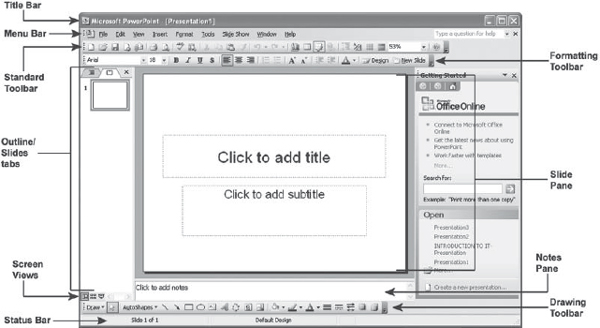
Figure 12.1 MS PowerPoint Window
4. What are the various ways to create a presentation? Explain by taking a suitable example.
Ans.: Whenever you start PowerPoint, it opens a new blank presentation and the Getting Started task pane, which enables to access online help and content, opens existing presentations and creates a new presentation. To create a new presentation, click Create a new presentation on the Getting Started task pane, to display New Presentation task pane. A new presentation can be created using three methods: AutoContent Wizard, Design Template, and Blank Presentation.
Using the AutoContent Wizard
The AutoContent Wizard helps you to create and structure the content of a presentation in a clear and logical way. It helps in creating a presentation by leading the user through some basic steps. The wizard then uses answers to automatically layout and format the presentation. PowerPoint 2003 then selects the best style and built-in outline to suit the presentation. This wizard helps to create a presentation quickly and easily and is very helpful for new users. To create a presentation using this wizard, follow the steps given below:
- Select From AutoContent Wizard from the New Presentation task pane to display the AutoContent Wizard dialog box. Click Next to continue to the next step (Figure 12.2).

Figure 12.2 Step 1 of AutoContent Wizard
- The Wizard displays various categories of presentations, such as All, General, Corporate, Projects, and Sales/Marketing. The box adjacent to these categories displays the available presentations for the category selected. Select the desired presentation and click Next (Figure 12.3).
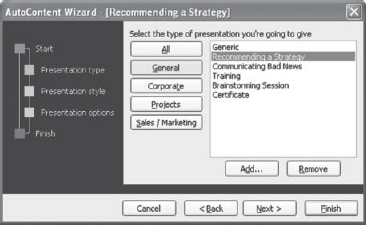
Figure 12.3 Step 2 of AutoContent Wizard
- The next decision is to select the output type. One can present the slide show on an overhead projector, computer screen, etc. Select the desired output type and click Next (Figure 12.4).
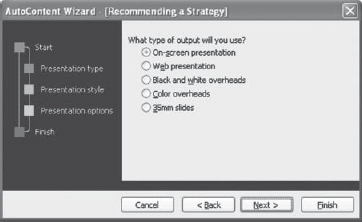
Figure 12.4 Step 3 of AutoContent Wizard
- Enter the presentation title, which you want to display in each slide inside the Presentation title box. One can also include information such as the company name or the name of the department in the Footer box. There are two check boxes as well. One includes a date on which the presentation was last updated and the other adds the slide number. Select the desired option and click Next (Figure 12.5).

Figure 12.5 Step 4 of AutoContent Wizard
- Click Finish to create the presentation (Figure 12.6). The specified presentation appears on the screen.
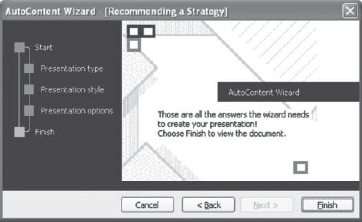
Figure 12.6 Step 5 of AutoContent Wizard
Using Design Template
PowerPoint provides many built-in slide sets (templates) with different backgrounds and text formatting to create a presentation. A design template includes pre-formatted layouts, fonts, and colours, which blend together to give a consistent look to the presentation.
If you choose Design Template, a new presentation is displayed using the design selected by the user, consisting of a single slide. This option allows you to create a presentation, maintaining a consistent design scheme like layouts, colours, fonts, etc. To use the Design Template, follow the steps given below:
- Select From design template from the New Presentation task pane to display Slide Design task pane that shows various design templates (Figure 12.7).
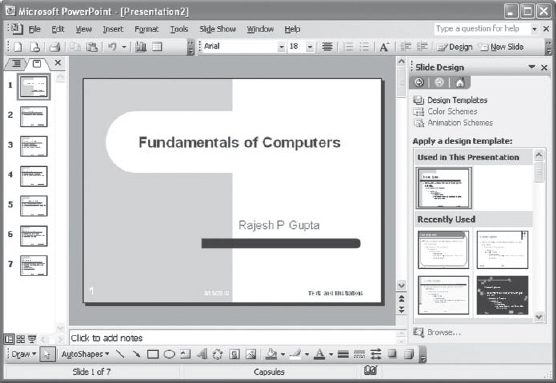
Figure 12.7 Design Templates
- Choose the template for the slide from Apply a design template section. The slide with the selected design template appears. It is to be noted that MS PowerPoint 2003 contains readymade design templates each having its own layout, font styles, font colours, etc.
Using Blank Presentation
The most basic method of creating a slide show presentation is by using Blank Presentation. This method is used to start the whole process of creating presentation from scratch. In other words, it includes no preset design, colour, or content suggestion. To use the Blank Presentation, follow the steps given below:
- Select Blank Presentation from the New Presentation task pane to display a new blank slide and the Slide Layout task pane (Figure 12.8).
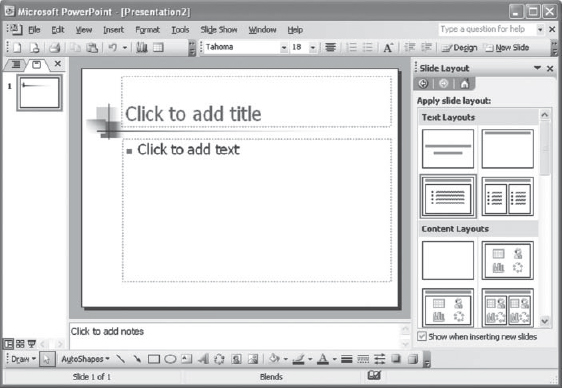
Figure 12.8 Blank Presentation
- Choose the layout of the slide. It is to be noted that PowerPoint 2003 includes 27 different types of layouts, known as AutoLayouts. The selected layout is applied to the slide.
5. Write in brief on different views of MS PowerPoint.
Ans.: PowerPoint provides different types of screen layouts for constructing presentation in addition to the slide show. View is a way in which one can see and work with the presentation and slides. A user can select the page view by clicking the screen view buttons on the left hand side at the bottom of the window. PowerPoint offers three different views for users: normal view, slide sorter view, and slide show view.
Normal View
The default view in PowerPoint 2003 is the Normal view, which makes the most commonly used components of a presentation easily accessible to the user. This view contains three working areas: slide and outline tabs on the left, the slide pane on the right, and notes pane at the bottom. Normal view enables to see various aspects of the presentation simultaneously in two different tabs:
- Outline tab: This tab enables a user to write and edit the content of presentation. When the text is selected in the outline tab, the buttons for working with outline become available on the Standard and Formatting toolbars. One can use these buttons to organize the presentation like increasing and decreasing the text indents, expanding and reducing the content, etc. (Figure 12.9).
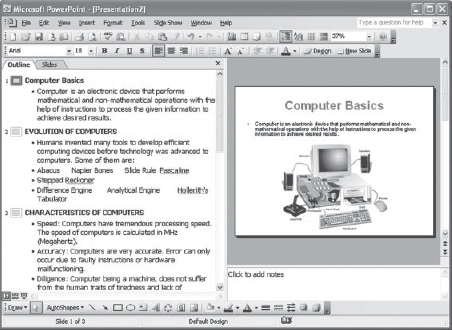
Figure 12.9 Outline Tab in Normal View
- Slides tab: This tab displays the slides as thumbnail-sized images. It is helpful for navigating through presentation, seeing the effects of design changes, adding, deleting, or rearranging slides (Figure 12.10).
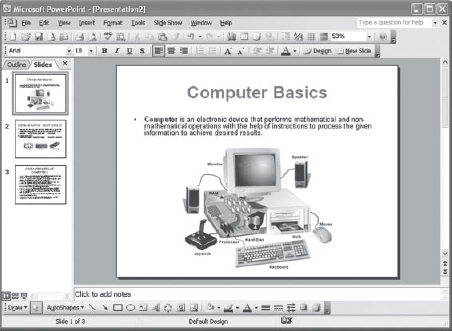
Figure 12.10 Slides Tab in Normal View
Slide Sorter View
This view option displays all the slides in a presentation as thumbnails. In simple terms, all the slides in a presentation are displayed on the screen at the same time in a miniature form. It helps the user to add, delete, and rearrange the slides. Also, transition effects can be added for moving from one slide to another in a convenient manner. Thus, it acts like a preview tool (Figure 12.11).
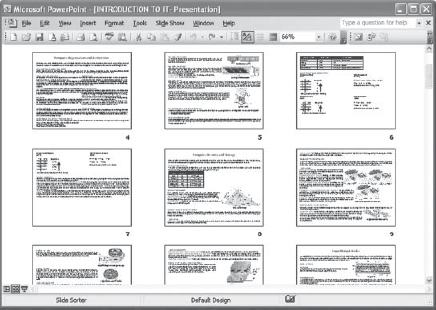
Figure 12.11 Slide Sorter View
Slide Show View
This view is used when you want to deliver a presentation. Its option allows you to view the slides (full screen) as they would appear in a slide show (Figure 12.12).
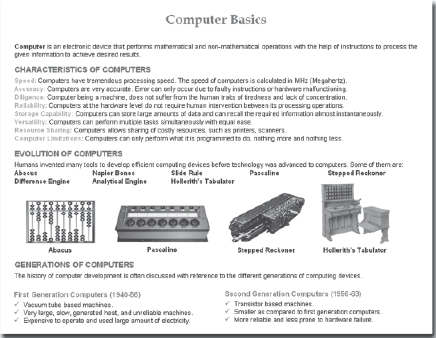
Figure 12.12 Slide Show View
6. What is the role played by masters in PowerPoint? Discuss various masters available in PowerPoint.
Ans.: Masters in PowerPoint are used to control many facets of the slides such as backgrounds, font typeface, font size, colours, bullets and locations for all main components, tabs, and indents. PowerPoint has three masters: Slide Master, Notes Master, and Handout Master.
Slide Master
PowerPoint automatically assigns a slide master to every presentation. The slide master allows you to customize the look of each slide and also ensures consistency across your presentation. In the slide master, you can change fonts, bullets, and header and footer information. Use the slide master to add a picture, change the background, adjust the size of the placeholders, and change font style, size, and colour. To view or change the formatting in the slide master, select Master from the View menu and choose Slide Master (Figure 12.13).
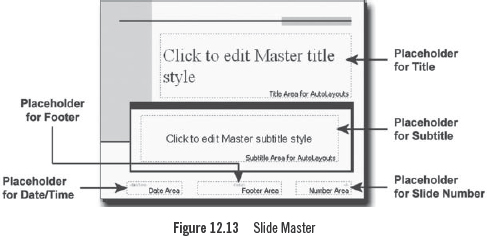
Figure 12.13 Slide Master
Notes Master
PowerPoint helps to create notes that will stay with the presentation. This feature provides an area for the speaker notes, along with a reduced picture of the slide. To view the Notes master, select Master from the View menu and choose Notes Master. In Notes Master, you can add bullets and page numbers, resize slides or the text placeholders on slides, or change fonts. You can also modify the style of the text that will appear in the printouts of your notes (Figure 12.14).
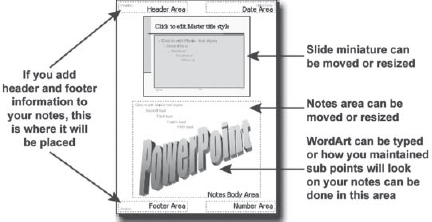
Figure 12.14 Notes Master
Handout Master
In handout master, you can add images, text, and colour to your handouts. In addition, you can add header and footer to the slides and also view these slides in different ways, such as one, two, three, four, six, nine, the outline, and layout views (Figure 12.15). To view the handout master, select Master from the View menu and choose Handout Master. The information added in the handout master is not visible while working with the presentation, but will be available when it is printed.
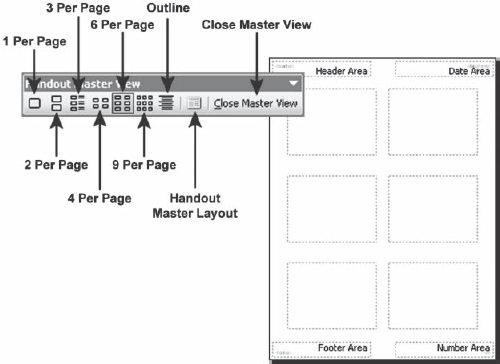
Figure 12.15 Handout Master
7. Explain the steps to insert a new slide in a PowerPoint presentation.
Ans.: Sometimes, you may need to add new slides to the presentation. Slides can be added in all views except the Slide Show view. To insert a slide, follow any one of the steps given below:
| Choose New Slide from the Insert menu. | |
| Click New Slide button ( |
As you follow any of these steps, the Slide Layout task pane appears from which you can choose the desired layout for the new slide.
8. Write the steps to remove a slide from a presentation.
Ans.: You can also remove a slide from a presentation. To delete slide, select the slide and follow any of the steps given below:
| Select Delete Slide from the Edit menu. To delete multiple slides, choose Slide Sorter view, hold down the Ctrl key to select multiple slides and then click Delete Slide. | |
| Right-click on the slide and perform cut option. This option works only in case of Slide Sorter view. |
9. How do you duplicate a slide?
Ans.: PowerPoint allows you to easily make copies of one slide. This may be required if you want to use same data in more than one slide. Note that when duplication is done the layout is also copied. To duplicate slide, follow the steps given below:
- Select the slide or slides that you want to duplicate.
- Select Duplicate Slide from the Insert menu. To duplicate multiple slides, click on one slide and press Shift (for selecting contiguous slides) or Ctrl (for selecting non-continuous slides) to select multiple slides.
10. Discuss various ways to add text to slides.
Ans.: There are a number of ways in which text can be added into the slides. Text can be added using text placeholder, text box, or an AutoShape.
Adding Text Using Placeholder
PowerPoint includes 27 types of AutoLayouts for creating slides. Many of these layouts contain text placeholders for titles, body text, and bulleted lists. To add text in placeholder, click in the placeholder and type the text. You can change the size and position of a text placeholder or apply a different AutoLayout to an existing slide, at any time while creating a presentation.
Adding Text Using Text Box
Text in slides can also be added through the use of text box. The text box is available on the Drawing toolbar. Note that if the Drawing toolbar is not visible, then right-click anywhere on the menu bar and select Drawing from the pop-up menu. To add text in the slide using text box, follow the steps given below:
- Select the slide where you want to add a text box.
- Click Text Box button (
 ) on the Drawing toolbar.
) on the Drawing toolbar. - Select the area in the slide where you want to place the text box and start writing the text in the text box.
Adding Text to an AutoShape
Text can also be added in an AutoShape. It contains several categories of shapes, including lines, basic shapes, flowchart elements, stars and banners, and callouts that you can use in your presentation. To add text in an AutoShape, follow the steps given below:
- Select the AutoShapes option from the Drawing toolbar.
- Choose a shape from the list of options available. Note that the chosen shape has a background colour, which makes it invisible.
- To add text, right-click the shape and click Add Text.
11. What is transition effect? How can you choose and apply transition to a slide?
Ans.: Transition effects are used to insert effects between slides. They are also used to indicate a new section of a presentation or to emphasize a certain slide. You can choose from a variety of transitions, which are present in PowerPoint 2003. They can be added in the Slide Show or Slide Sorter view. To add transition effects, follow the steps given below:
- Select Slide Transition from the Slide Show menu to display the Slide Transition task pane (Figure 12.16).
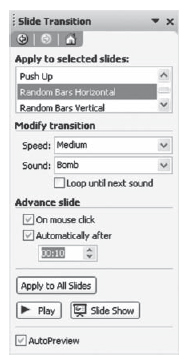
Figure 12.16 Slide Transition Task Pane
- Select the desired transition from the Apply to selected slides section, to apply the transition to the displayed slide (Figure 12.17).

Figure 12.17 Selecting Transition
- Select various options under Modify transition section to change the speed and sound of the transition.
12. How can you set the slides timing?
Ans.: You can insert time between the slides in the slide show. This is required when there is some narration over the slides, or there is some graphical representation, which needs proper explanation. If you do not want to manually move through a slide show, there are two ways to set the length of time for which the slide appears on the screen. Firstly, you can set a time manually for each slide, and then run the slide show and view the timings that have been set. Otherwise, you can use the Rehearsal feature. Here, you can record the timings automatically as you rehearse. You can also adjust the timings that you have already set and then rehearse the new ones. To add time using this feature, follow the steps given below:
- Select Rehearse Timings from the Slide Show menu. This starts the slide show with a Rehearsal toolbar that appears at the corner of the screen, as shown in Figure 12.18.

Figure 12.18 Rehearsal Toolbar
- The timer appears in the upper left-hand corner of the slide and begins to count down the seconds. The white box refers to the timing for each slide. The other timer refers to the total length of the slide show.
- If a user want to repeat the rehearsal of a slide, click the Repeat button (
 ) on the Rehearsal toolbar. The current slide repeats and the timing for it starts again.
) on the Rehearsal toolbar. The current slide repeats and the timing for it starts again. - Rehearse the presentation until it is finished. After the presentation is complete, a message box appears. It displays the final running time and presents a message, as shown in Figure 12.19.

Figure 12.19 Message Box
- Click Yes to record the new slide timings or No to return to the PowerPoint window.
13. Write the steps to highlight parts of the slide show.
Ans.: You can use the highlighting option while you are giving the presentation to add emphasis to important information. To highlight a slide during a slide show, follow the steps given below:
- Select View Show from the Slide Show menu.
- Right-click in the slide and select Highlighter from the Pointer Options.
- Click and hold the highlighter on the slide. Drag the highlighter around the area on the slide you want to highlight until a line encircles the text.
- Right-click in the slide and select Arrow from the Pointer Options to change the highlighter back to the mouse pointer.
14. How is ClipArt useful in PowerPoint?
Ans.: In MS PowerPoint, you can insert the built-in ClipArt images in our slides. The ClipArt objects are designed professionally and are visually very attractive. The ClipArt gallery contains a variety of objects like pictures, photographs, sounds, and video clips. Thus, it helps in making the slides visually more impressive. You can insert the ClipArt in the same way as discussed in the previous chapters.
15. Write the steps to create a chart in MS PowerPoint.
Ans.: To create a chart in a PowerPoint slide, follow the steps given below:
- Choose Chart from the Insert menu or click the Insert Chart icon (
 ) on the Standard toolbar. The chart along with the sample datasheet appears on the slide (Figure 12.20).
) on the Standard toolbar. The chart along with the sample datasheet appears on the slide (Figure 12.20).

Figure 12.20 Inserting a Chart
- Change the sample data given in datasheet if required. As you update the datasheet, the chart also changes accordingly. You can change the labels also as per your requirement.
- If the sample chart does not suit best to your requirement, you can choose from other chart types. For this, follow any of the steps given below:
- Click the down arrow beside the Chart Type icon (
 ) on the Standard toolbar and choose the desired chart type from the drop-down list box that appears (Figure 12.21). Note that this icon appears on the Standard toolbar only when you double-click the chart present on the slide.
) on the Standard toolbar and choose the desired chart type from the drop-down list box that appears (Figure 12.21). Note that this icon appears on the Standard toolbar only when you double-click the chart present on the slide.

Figure 12.21 Different Chart Types
- Choose Chart Type from the Chart menu to display the Chart Type dialog box (Figure 12.22). This dialog box displays various available chart types in the Chart type list box and the subtypes of the chart selected in Chart type list box under the Chart sub-type section. Choose the desired chart type and sub-type and click OK to close this dialog box.
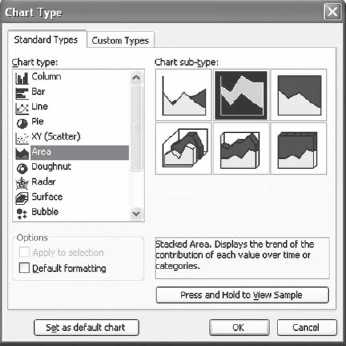
Figure 12.22 Chart Type Dialog Box
As you perform any of the above-mentioned steps, the chart present on the slide changes accordingly as shown in Figure 12.23.
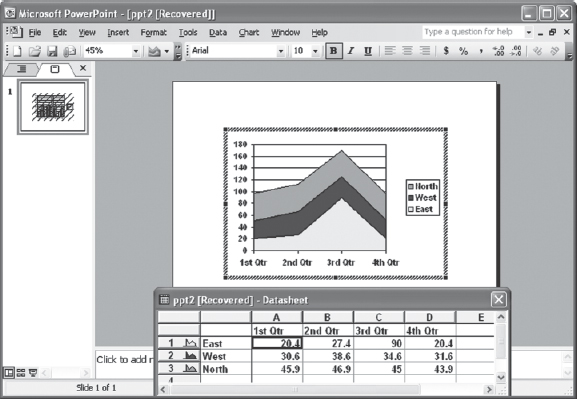
Figure 12.23 Final Layout
- Click the down arrow beside the Chart Type icon (
16. Write the steps to insert an animation in a slide? How can we make customized animations?
Ans.: Animation effects are added to grab the audience's attention as well as to reinforce some important point that needs to be highlighted. Animation can be in terms of special sound or visual effects, which are added to the text or other objects such as a chart or picture. To add animation effects to a slide or the entire presentation, follow the steps given below:
- Click on the placeholder that contains the text or graphic that you wish to animate.
- Select Animation Schemes from the Slide Show menu to display Slide Design task pane (Figure 12.24).
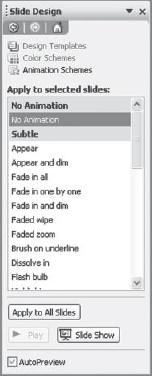
Figure 12.24 Slide Design Task Pane
- Select the desired animation scheme from the Apply to selected slides section. The selected animation scheme is applied to the current slide.
- To apply the selected animation scheme to all slides, select Apply to All Slides.
Custom Animations
Custom animations offer more control over the animation. You can choose the order of the slides on which animation is applied as well as decide the direction the animation should travel in, apply a sound to the animation, and decide how the text appears in the slides. To add custom animation, follow the steps given below:
- Select the text or graphic to animate.
- Right-click text or graphic and select Custom Animation from the shortcut menu, or select Custom Animation from the Slide Show menu. This displays the Custom Animation task pane (Figure 12.25).
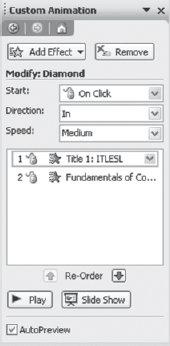
Figure 12.25 Custom Animation Task Pane
- Select various effects from Add Effect to assign animation to the objects.
- Once the effects have been applied, they can also be modified by setting various options in the Modify section.
17. Write the steps to run the slides.
Ans.: PowerPoint provides a number of ways to view and deliver presentations so that they are well designed and look professional. You can use the Slide Show to review a presentation before printing it or to prepare to show it electronically. To view the slide show, perform any of the steps given below:
| Select Slide Show from the View menu. | |
| Select View Show from the Slide Show menu. | |
| Click on the Slide Show view button ( |
While in the slide show view, you can right-click anywhere on the screen to display a pop-up menu containing a number of options. Some of the important options are listed in Table 12.1.
Table 12.1 Slide Show Buttons
Options |
Description |
Next |
It moves to the next slide. |
Previous |
It moves to the previous slide. |
Last Viewed |
It moves to the last viewed slide in the presentation. |
Go to Slide |
It moves to a specific slide in the presentation. |
Pointer Options |
It adds information using pen. |
Help |
It views the Slide Show Help. |
End Show |
It ends the slide show. |
18. What is the purpose of Package for CD feature? How do you use this feature?
Ans.: A presentation can be created both for business or professional use. For example, you may create a presentation that is to be delivered at some conference. To deliver a presentation, only the presentation file is needed. In case of a small presentation, you can easily carry the file in one floppy. However, this approach may not work well for larger presentations especially one with lots of graphics. PowerPoint contains a useful feature called Package for CD, which solves the above problem and also allows you to view the presentation file on a computer that does not have PowerPoint installed. To use this feature, follow the steps given below:
- Select Package for CD from the File menu to display the Package for CD dialog box (Figure 12.26).
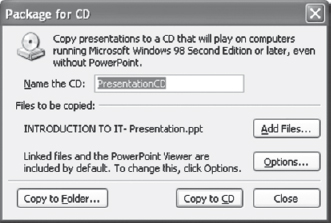
Figure 12.26 Package for CD Dialog Box
- Type the name for your folder or CD in Name the CD text box.
- Select Add Files to include more than one file from your computer.
- Select Options to display Options dialog box (Figure 12.27). This dialog box has the following options:
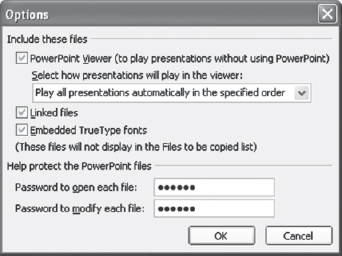
Figure 12.27 Options Dialog Box
- PowerPoint Viewer: Select this checkbox to play the presentation, even if the destination computer does not have PowerPoint 2003 installed.
- Linked files: Select this checkbox to include all linked files.
- Embedded TrueType fonts: Select this checkbox to display the font correctly, even if the destination computer does not have particular font installed.
- Password to open each file: Provide password to open the PowerPoint presentation.
- Password to modify each file: Provide password to modify the PowerPoint presentation.
- Click OK to close the Options dialog box and return to the Package for CD dialog box.
- Finally, to copy the files to a folder or to a CD, click the corresponding button.
19. Make a dynamic presentation of your seminar in PowerPoint. Give all the steps to be followed for making electrifying presentation using multimedia effects.
Ans.: Suppose you have to create a presentation on the Bluetooth technology. To prepare this presentation, follow the steps given below:
- Create a new presentation using the design template. For this, choose New from the File menu to display New Presentation task pane. Click From design template in this task pane to display the Slide Design task pane. Apply the desired design template from the Slide Design task pane (refer Q4).
- Add an appropriate title and/or subtitle to the slide by clicking in the ‘Click to add title’ and ‘Click to add subtitle’ placeholders (Figure 12.28).
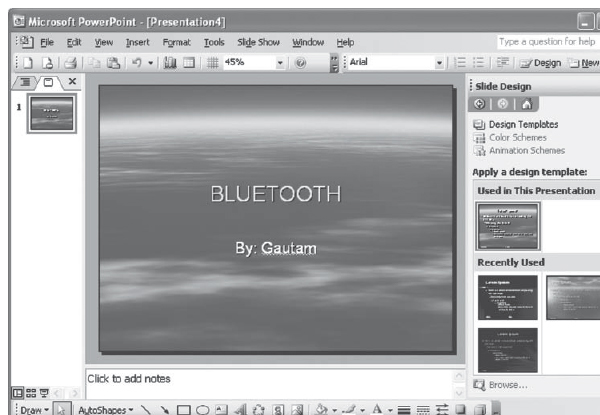
Figure 12.28 Adding Title and Subtitle
- Save your presentation by choosing Save As option from the File menu.
- Insert new slides as per your requirement by clicking the New Slide button on the Formatting toolbar or by selecting New Slide from the Insert menu.
- Add appropriate text to the new slides.
- Design the slides by inserting bullets, numbering, pictures, ClipArts, or AutoShapes at appropriate places as shown in Figure 12.29.
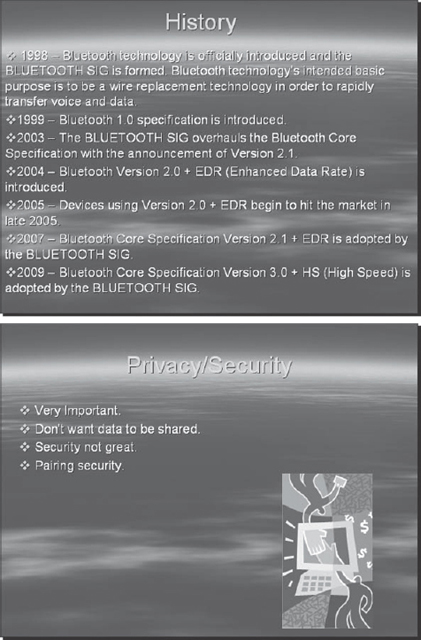
Figure 12.29 Designing the Slides
- Add transition effects to your slides. For this, choose Slide Transition from the Slide Show menu to display the Slide Transition task pane. Choose the desired transition from the available options in this task pane and apply to the slides (refer Q11). You can also add a sound effect.
- Set the timings between slides by choosing the Rehearse Timings from the Slide Show menu. This displays the Rehearsal toolbar where you can specify the desired timings (refer Q12).
- Add the desired animation to the slides. For this, choose Animation Scheme from the Slide Show menu to display the Slide Design task pane. The different styles of animations appear in this task pane. Select the animation you want to insert and then apply to the desired slides (refer Q16).
- After adding various multimedia effects, view your presentation by choosing View Show from the Slide Show menu (refer Q17).
Multiple-choice Questions
1. Which of the following is not a command of the File menu?
(a) Open
(b) New
(c) Undo
(d) Print
2. ____________ wizard helps to create a presentation in a quick way and is very helpful for new users.
(a) AutoContent
(b) Design Template
(c) Blank Presentation
(d) None of these
3. A ____________ template includes pre-formatted layouts, fonts, and colours.
(a) Slide
(b) Layout
(c) Design
(d) Formats
4. Which of the following presets is not included in the Blank presentation?
(a) Preset design
(b) Colour
(c) Content suggestion
(d) All of these
5. ____________ view option displays all the slides in a presentation as thumbnails.
(a) Normal view
(b) Slide Show view
(c) Slide Sorter view
(d) None of these
6. ____________ are used to insert effects between slides. They are also used to indicate a new section of a presentation or to emphasize a certain slide.
(a) Drawing toolbar
(b) Transition effects
(c) Logos
(d) None of these
7. The ____________ gallery contains a variety of objects like pictures, photographs, sounds, and video clips.
(a) Image
(b) ClipArt
(c) Animation
(d) Layout
8. ____________ are added to grab the audience's attention as well as to reinforce the point that needs to be highlighted.
(a) Animation effects
(b) Transition effects
(c) Screen views
(d) Package for CD
Answers
1. (c)
2. (a)
3. (c)
4. (d)
5. (c)
6. (b)
7. (b)
8. (a)
